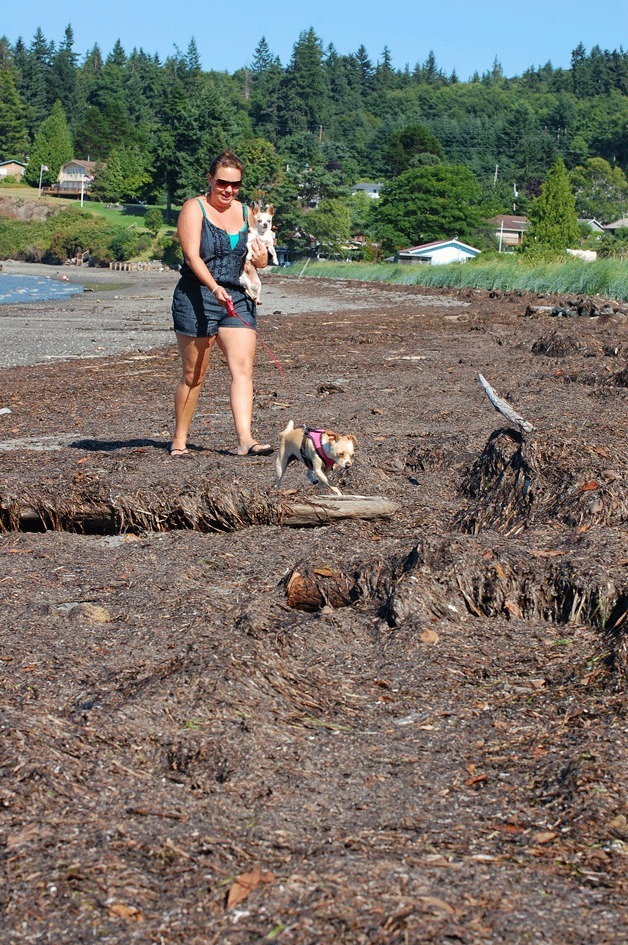Twice a day, Lila Haynes and her two Chihuahuas take a walk along the beach at Freeland park.
It’s a walk they all love. Little Copper and Ava get the chance to investigate countless curiosities and irresistible smells and for Haynes, it’s a chance to stretch her legs and enjoy the waterfront.
They do it so often, it’s become something of a ritual. So too has the exercise of carefully wiping down their paws after each walk.
As if the no swimming and shellfish harvesting signs aren’t cause for enough concern, the deep piles of organic debris that dominate the shoreline has always seemed, well, dirty. Too dirty, in fact.
“It’s full of yuck,” she laughed.
Turns out, her worries weren’t unfounded. Island County health officials are now investigating whether the organic beach debris may be one of the sources of the fecal coliform bacteria that resulted in the creation of the Holmes Harbor Shellfish Protection District in 2007.
Keith Higman, director of Island County Community Health, emphasized that the organic beach material, known as wrack, is no “smoking gun” for the harbor’s fecal coliform woes. However, it may very well have been a contributing factor, he said.
“There is no one single factor — it was lots of things,” Higman said. “That’s why it’s taken such a comprehensive approach.”
Wrack consists mostly of eel grass that has washed ashore. Acting like a sponge, it traps debris that ranges from dead crabs and bird feathers to, possibly, fecal coliform bacteria itself.
Every time the tide comes in, it comes into contact with the water and may be the reason the county’s test results continue to reveal unacceptable levels of the bacteria on the shoreline.
There is certainly enough of the stuff to contaminate results, he said.
“In some places, it’s a foot thick,” Higman said.
Water testing in 2006 revealed unacceptable levels of the fecal coliform. In response, the state Department of Health shut down all shellfish harvesting in the area and directed the Island County commissioners to form the district.
Required to take corrective measures to find the problem and restore water quality to within state standards, the county has been working for about five years to address the problems.
Along with ramping up efforts to identify a source of the contamination, such as a malfunctioning septic system, the county implemented public education campaigns focused on animal waste and installed specialized storm drain systems in the hopes of improving water quality.
Those efforts began to pay off with cleaner and cleaner water quality samples. Fresh water monitoring was consistently finding acceptable levels of the bacteria, though shoreline testing was not.
Earlier this year, the county submitted testing data and Jule Schultz, the restoration lead at the state Department of Health’s Office of Shellfish and Water Protection, expressed optimism that the days of the protection district may be numbered.
Higman and several of his staff met with Schultz late last month to discuss the county’s progress and what will come next. Although Schultz could not be reached directly for this story, he said in a message to the Record that freshwater outfall testing results appeared good.
However, he said he would not be able to immediately recommend a lift of the shellfish closure due to poor testing results along the shoreline.
“Near shore marine water quality is something we still have concerns about and we need to do more thorough evaluation,” Schultz said.
Higman said Schultz was the one who suggested that the wrack is a contributor. Apparently, it’s been identified as a problem in Larrabee State Park on Samish Bay near Bellingham, Higman said.
It’s a little unclear what exactly will happen next but Schultz said he would be working with the county to develop a plan to look more closely at the wrack and develop mitigation methods.
Higman expects it could be weeks or months before any concrete course of action is determined. In the mean time, he said the county would continue its current efforts while also turning some of its focus toward the newly identified possible contributor.
As for Haynes, she wasn’t too surprised to learn that her long-held suspicions about the beach debris may in fact be true. She comes down every Saturday and picks up litter and dog poop on the beach and a lot of it is in the wrack, she said.
But even if she didn’t, its potential as a health hazard would still be obvious. All you have to do is look at it to know why.
“It’s common sense,” she said.



